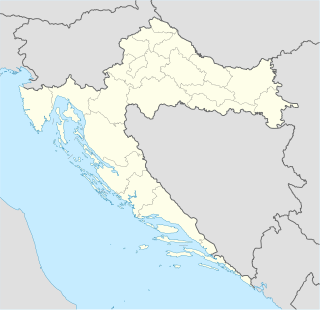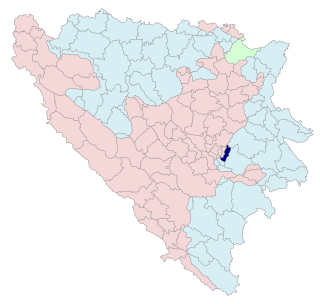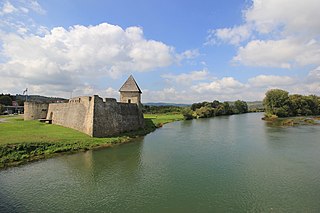
Koprivnica-Križevci County is a county in northern Croatia. Its hyphenated name comes from two entities: the two of its largest cities, Koprivnica and Križevci.

Stari Grad is a municipality of the city of Sarajevo, Bosnia and Herzegovina. It is the oldest and most historically significant part of Sarajevo. At its heart is the Baščaršija, the old town market sector where the city was founded by the Ottoman general Isa-Beg Isaković in the 15th century.

Koprivnica is a city in northern Croatia. It is the capital of the Koprivnica-Križevci county. In 2011, the city's administrative area of 90,94 km² had a total population of 30,854, with 23,955 in the city proper.

Hvar is a Croatian island in the Adriatic Sea, located off the Dalmatian coast, lying between the islands of Brač, Vis and Korčula. Approximately 68 km (42.25 mi) long, with a high east-west ridge of Mesozoic limestone and dolomite, the island of Hvar is unusual in the area for having a large fertile coastal plain, and fresh water springs. Its hillsides are covered in pine forests, with vineyards, olive groves, fruit orchards and lavender fields in the agricultural areas. The climate is characterized by mild winters, and warm summers with many hours of sunshine. The island has 11,103 residents, making it the 4th most populated of the Croatian islands.

Stari Grad is a town on the northern side of the island of Hvar in Dalmatia, Croatia. One of the oldest towns in Europe, its position at the end of a long, protected bay and next to prime agricultural land has long made it attractive for human settlement. Stari Grad is also a municipality within the Split-Dalmatia County.

Baščaršija is Sarajevo's old bazaar and the historical and cultural center of the city. Baščaršija was built in the 15th century when Isa-Beg Isaković founded the town. The word Baščaršija derives from the Turkish language. The word "baš" which is "baş" in Turkish literally means "head", in some contexts however also "primary", "main", "capital" and "čaršija" which is "çarşı" in Turkish means "bazaar" or "market". Due to the large fire in the 19th century, today Baščaršija is half the size that it once was.

Podravina or Podravje are Slavic names for the Drava river basin in Croatia and Slovenia.

Istočni Stari Grad is a municipality of the city of Istočno Sarajevo located in Republika Srpska, an entity of Bosnia and Herzegovina. As of 2013, it has a population of 1,131 inhabitants.

Đurđevac is a town and municipality in the Koprivnica-Križevci County in Croatia. According to the 2011 census, there are a total of 8,264 inhabitants in the municipality, in the following settlements:

Vrboska is a settlement on the north coast of the island of Hvar in Dalmatia, Croatia, in the Municipality of Jelsa. Founded in the 15th century as a fishing harbour, Vrboska is best known for the fortress Church of Sv. Marija, built as a refuge for its inhabitants during the 16th century. Vrboska has a population of 526 at the 2001 census.

Tvrdalj Castle is a castle in Stari Grad, on the island of Hvar, Croatia.

Balbi's Arch, in Rovinj, Croatia, was built in 1678–79. The arch leads to Grisia Street. On one side, there is the carved head of a Turk while on the other side is the carved head of a Venetian. It stands on the site of the old town gate.

Kaštel Kambelovac is a town within the administrative area of Kaštela in Dalmatia, Croatia.

Zrinski Park is situated in downtown Čakovec, northern Croatia, close to the central square.

Fortress Kastel is a castle in Hrvatska Kostajnica, a town in central Croatia, near the border to Bosnia and Herzegovina.
Polhov Gradec Castle is a castle ruin above the settlement of Polhov Gradec, in the Municipality of Dobrova–Polhov Gradec in central Slovenia. It is located on Calvary Hill immediately northwest of the town center.

Stari Grad is a settlement east of the town of Krško in eastern Slovenia. The area was traditionally part of Styria. It is now included with the rest of the municipality in the Lower Sava Statistical Region.
Čivićevac is a perennial stream in Koprivnica-Križevci County, Croatia, flowing near the center of the town of Đurđevac.

The House of Orehovečki was a Croatian noble family, descending from Sveti Petar Orehovec in the former Bjelovar-Križevci County, where it had its largest estates, and reached its peak in the 17th century. Thanks to the marriage connections, it was connected to many influential noble families like Keglević, Patačić, Ratkaj, Alapić etc. Notable members of the family were important state officials, military officers, Catholic Church prelates and so on.




















